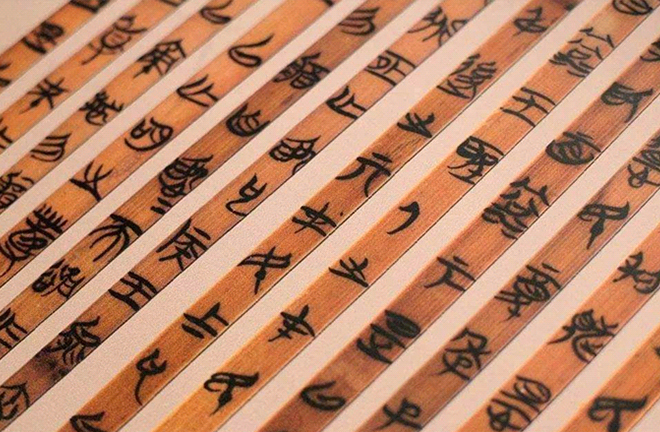
Guodian Chu Slips Photo: FILE
Ancient writings, more specifically pre-Qin writings, include Yin and Shang oracle bone inscriptions, bronze inscriptions from the Zhou Dynasty (1046–256 BCE) as well as writings from the Warring States Period (475–221 BCE), Qin Dynasty (221–207 BCE) and early Han Dynasty (206 BCE–220). Huang Dekuan, director of Unearthed Research and Protection Center at Tsinghua University, said that ancient writings’ historical and cultural information, embedded in the development of their structure and form, show the characteristic of originality. Paleography helps reveal the structure of Chinese characters and their law of historical development, thereby exploring the mystery of Chinese civilization.
The writings from the Warring States Period are the earliest ancient characters discovered and studied. As early as the Han Dynasty, Chinese scholars began to study the writings of the Warring States Period. During the transition between the Qing Dynasty (1644–1912) and the Republic of China (1912–1949), scholars such as Chen Jieqi, Wu Dacheng, Ding Foyan, Luo Zhenyu and Wang Guowei collected and sorted out ancient writing materials, which laid a solid academic foundation for the study of paleography, said Xu Zaiguo, director of the Research Center for Development and Application of Chinese Characters at Anhui University.
The discovery of oracle bone inscriptions in 1899 is of great significance in the history of ancient philology. It silenced the international academic community who doubted the existence of China's Yin and Shang era, and it promoted paleography, represented by oracle bones, to global academia. Ancient Chinese writing materials became cultural resources with the greatest historical significance. Liu Zhiji, deputy director of the Chinese Character Research and Application Center at East China Normal University, said that through the study of ancient writing materials, we can understand the wisdom and lifestyle of ancient ancestors. Song Zhenhao, Member of the Chinese Academy of Social Sciences, said that oracle bone inscriptions are the origin of Chinese characters and the Chinese language as well as a progenitor of the Chinese cultural gene. Their contents are vast and varied. They are the most authentic material for reconstructing ancient Chinese history.
Since the discovery of the oracle bone inscriptions more than 100 years ago, 160,000 pieces of oracle bones, a large number of Shang and Zhou bronze inscriptions, and Qin and Han bamboo slips and silk books have been unearthed. Huang said the discovery of these materials has provided sufficient evidence for the development of Chinese characters in various periods and an unprecedentedly rich resource for receiving and passing down the unique culture of Chinese characters. Also, the discovery has allowed the paleography community to more comprehensively and clearly understand the transformation of Chinese characters from ancient times to present.
Focusing on the Guodian Chu Slips, Xu Zaiguo explored the significance of paleography in the study of Chinese characters. He described how the over 800 bamboo slips unearthed in Guodian Village, Jingmen, Hubei Province, fundamentally rewrote the history of the study of Chu slips. Many characters were impossible to interpret before the discovery. Scholars identified some of them by comparatively examining the Guodian Chu Slips and ancient documents, greatly promoting the textual research concerning the Warring States Period.
Paleography, as an ancient science, is developing into a new interdisciplinary subject in the context of the development of modern subjects. Huang said that paleography involves many disciplines such as history, linguistics and archaeology. The research methods of these disciplines should be comprehensively applied to paleography. To improve the disciplinary construction of paleography, we must first make a scientific plan for this new interdisciplinary field and propose targeted measures based on its disciplinary characteristics; secondly, we should build a talent team as a fundamental task and support young scholars who are interested in researching this discipline; furthermore, it is necessary to reform the evaluation methods and standards for talent so that researchers’ academic contributions can be appropriately measured.
Song said, compared with past generations of scholars, today’s scholars enjoy research conditions with many favorable aspects. For example, the application of artificial intelligence and big data cloud computing has helped oracle bone studies reach new heights in the new era. Key technology research and development has included the in-depth AI recognition of oracle bone scripts, the construction of oracle-related big data, information and resource platforms, and the construction of oracle 3D data modeling archives.
Currently, many paleography research centers in China are committed to building intelligent platforms. Digital and even intelligent approaches have been introduced to paleography, creating a new form of academic ecology. Liu said that due to the digitization of the material carriers, the original materials may form new materials, which will generate new academic understanding. Image recognition technology, machine learning methods and deep learning are expected to support the intelligentization of the study of ancient writings.
edited by MA YUHONG

